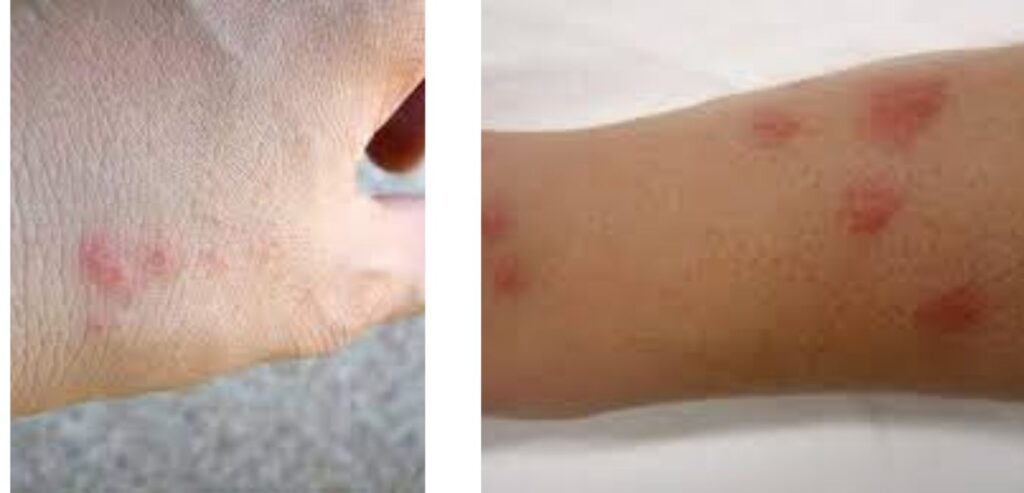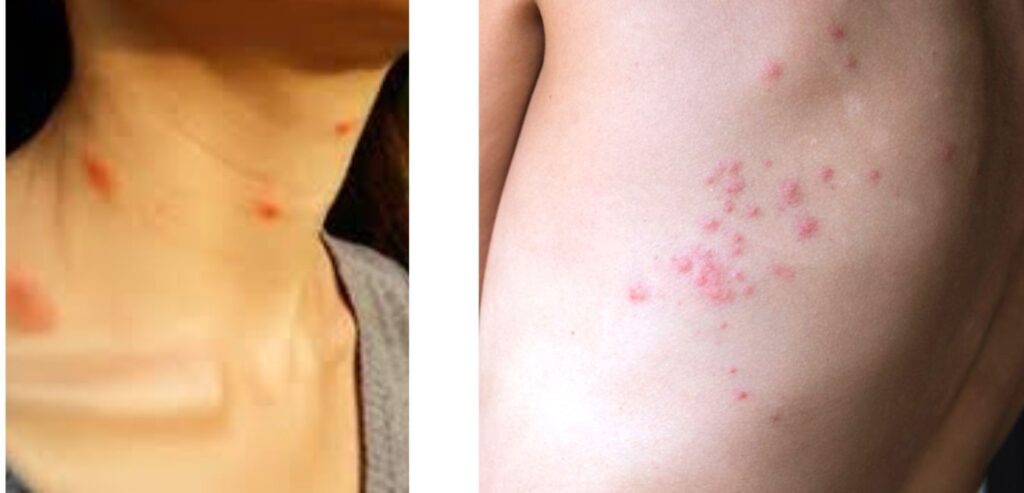What are Bed Bug Bites?
Bed bug bites are often the first sign that these pesky critters have infiltrated your home. These tiny, reddish welts can appear anywhere on your body, from your face down to your toes, leaving you scratching your head (and everywhere else).
Identifying Bed Bug Bites
So, how do you know if those itchy bumps are indeed from bed bugs? Well, bed bug bites typically form in a cluster or a line, resembling a small rash. They might also cause a burning sensation, unlike mosquito bites which tend to itch more.
The Telltale Signs
Spotting bed bug bites isn’t the only way to detect an infestation. Keep an eye out for other signs too, like blood stains on your sheets, rusty spots (which are bed bug excrement), or even a musty odor in your bedroom.
The Itch Factor
Ah, the notorious itchiness that accompanies bed bug bites! It’s like a tiny tormentor is whispering in your ear, “Scratch me, scratch me.” But beware, scratching can lead to skin irritation and even infection, so resist the urge as much as you can.
The Night time Predators
Ever heard of bed bugs being referred to as “night owls”? Well, it’s for a good reason. These sneaky insects prefer to feast on your blood while you’re peacefully snoozing, making your bed their buffet.
Bites Across Borders
Bed bugs aren’t just a problem in dingy motels or old homes; they can turn up anywhere, from five-star hotels to your best friend’s guest room. They’re like the uninvited guests who never seem to leave.
The Psychological Toll
Dealing with bed bug bites isn’t just about the physical discomfort; it can also take a toll on your mental well-being. The thought of tiny bugs crawling on you while you sleep can induce anxiety and paranoia, turning bedtime into a battleground.
Taking Control
So, what can you do if you suspect a bed bug infestation? Well, the first step is to confirm it by inspecting your mattress, furniture, and cracks and crevices around your home. Then, it’s time to call in the professionals or embark on a rigorous cleaning and extermination spree.

Bedbug Bites Signs Structure On Body
When it comes to bedbug bites, identifying them accurately is key to addressing a potential infestation. But what exactly do these bites look like, and how can you differentiate them from other insect bites?
- The Range of Reactions
According to Pest Control Technology, approximately 30 to 60% of people never develop a reaction to a bedbug bite. However, for those who do, the symptoms can vary widely.
- Red and Swollen
Bedbug bites may appear as red and swollen bumps on the skin, often with a dark spot at the center of each bite. This characteristic dark spot is a result of the bedbug’s feeding process, where it injects saliva into the skin to prevent blood clotting.
- Clustered Arrangements
One common characteristic of bedbug bites is their tendency to appear in lines or clusters, with multiple bites grouped. This pattern is a result of bedbugs feeding in one area before moving on to another, leaving behind a trail of bites.
- Itchy and Irritating
Perhaps the most notorious symptom of bedbug bites is the intense itching they provoke. The urge to scratch can be overwhelming, leading to further irritation and potential skin damage. This persistent itchiness is often what prompts individuals to seek out the cause of their discomfort.
- Burning Sensation
In addition to itching, bedbug bites may also cause a burning sensation on the skin. This burning feeling can vary in intensity and may exacerbate the urge to scratch, further aggravating the affected area.
- Fluid-Filled Blisters
In some cases, bedbug bites may develop into fluid-filled blisters, particularly if the individual has a hypersensitive reaction to the bites. These blisters can be painful and may require medical attention to alleviate discomfort and prevent infection.
- Evidence of Scratching
If you’ve been bitten by bedbugs, you may notice blood stains on your sheets or bedding from scratching the affected areas. These blood stains are a result of ruptured blood vessels caused by excessive scratching and can serve as a telltale sign of a bedbug infestation.

Most Common Spot On Body for Bed Bug Bites?
Bed bugs, those tiny terrors of the night, are notorious for their stealthy attacks on unsuspecting sleepers. But where do these pesky pests prefer to sink their fangs? Let’s dive into the details and uncover the most common spots where bed bug bites occur.
- The Neck:
Imagine drifting off into dreamland, only to wake up with itchy welts adorning your neck like a necklace of discomfort. Bed bugs often target the neck area, where the skin is tender and easily accessible, leaving behind a trail of irritation that’s hard to ignore.
- The Face:
Waking up to find your face peppered with bed bug bites is enough to send shivers down your spine. These unwelcome intruders have no qualms about nibbling on your cheeks, chin, or forehead as you sleep, leaving behind a collection of red, swollen marks that can mar your morning routine.
- Hands and Arms:
As you toss and turn during the night, your hands and arms are in constant motion, making them easy targets for bed bugs lurking in your bedding. Whether you’re a stomach sleeper or a side sleeper, these areas are prime real estate for bed bug bites, resulting in a frustratingly itchy ordeal come morning.
- Shoulders:
Your shoulders may bear the weight of the world during the day, but at night, they bear the burden of bed bug bites. Whether you’re curled up in a fetal position or sprawled out like a starfish, bed bugs can find their way to your shoulders, leaving behind a reminder of their unwelcome presence.
- Legs:
As the night wears on, bed bugs may venture further down your body in search of fresh feeding grounds. Your legs, left exposed by the covers, become fair game for these persistent pests, resulting in a symphony of itching and scratching that can disrupt your sleep and leave you longing for relief.

Best Treatment For Bedbug Bites
Bedbug bites can be a real nuisance, leaving you itching and uncomfortable. But fear not, there are plenty of ways to alleviate the symptoms and get relief from these pesky pests.
- Over-the-Counter Solutions:
If you’re dealing with redness, inflammation, and itching from bedbug bites, over-the-counter (OTC) treatments can come to the rescue. Consider applying a steroid cream to decrease inflammation and itching, or taking an oral antihistamine to reduce the discomfort of itching and burning.
- Prescription Strength Relief:
For more severe symptoms, your doctor may prescribe a stronger antihistamine to help alleviate itching and promote better sleep. This can be especially helpful if you find yourself tossing and turning at night due to relentless itching from bedbug bites.
- Pain Relief Options:
Bedbug bites can sometimes cause swelling and pain, making it challenging to go about your daily activities. Taking an over-the-counter pain reliever can help reduce swelling and discomfort, allowing you to get back to your routine with minimal interruption.
- Home Remedies:
In addition to OTC medications, several home remedies can provide relief from the symptoms of bedbug bites. Consider applying a cold cloth or ice pack wrapped in a towel to reduce swelling and numb the affected area. Alternatively, a thin paste of baking soda and water can help soothe itching and inflammation.
- Rest and Recovery:
In most cases, bedbug bites will improve on their own with time and proper care. Remember to give your body the rest it needs to heal, and avoid scratching the bites to prevent further irritation and potential infection.
- When to Seek Medical Attention:
While most bedbug bites don’t require medical attention, there are times when it’s essential to seek help from a healthcare professional. If you experience severe swelling, blistering, or signs of infection, such as pus or warmth around the bite area, don’t hesitate to consult a doctor for further evaluation and treatment.
- a cold cloth or an ice pack wrapped in a towel
- a thin paste of baking soda and water

How Do I Know if I have bedbugs in My home?
Suspecting a bedbug infestation can send shivers down your spine, but knowing the signs can help you take swift action to address the problem. Here’s a comprehensive guide to spotting these elusive pests in your home.
- Signs of Bedbug Hideouts:
Bedbugs are master hiders, lurking in cracks, crevices, and other hidden spots during the day. Keep an eye out for them in household cracks, walls, luggage, bedclothes, mattresses, bed springs, bed frames, spaces under baseboards, loose or peeling wallpaper, electrical switch plates, conduits for electrical cables, and even sofas if someone is using it as a sleeping spot.
- Preferred Living Quarters:
Bedbugs typically set up camp near where people sleep, drawn by body heat and carbon dioxide. They’re not keen on long-distance travel, so they tend to stay put in the vicinity of their feeding grounds. This means you’re most likely to find them in bedrooms and sleeping areas.
- Nighttime Feeders:
Bedbugs are creatures of the night, feasting on their hosts from midnight until dawn. After their nighttime snack, they retreat to the same hiding spot they occupied before biting. This nocturnal behavior makes them especially challenging to detect during the day.
- Tell-Tale Traces:
While you may not spot the bedbugs themselves, you might discover evidence of their presence. Keep an eye out for drops of blood or small black dots of bug droppings in your bed. These telltale signs can provide valuable clues about a potential infestation.
- Seeking Professional Help:
If you suspect bedbugs have taken up residence in your home, it’s essential to seek assistance from a professional pest control company. Most companies offer free inspections and can provide expert guidance on the best course of action to eliminate the infestation.
- Avoiding Spread:
Until the infestation is resolved, it’s crucial to avoid visiting or sleeping at other people’s homes or hotels. This can help prevent the spread of bedbugs to other locations and minimize the risk of re-infestation.

how to Identify
Common characteristics of nymphs (young bed bugs) include:
- less than 5 mm in length
- whitish-yellow or clear-colored
- invisible without a microscope or magnifying glass
Adult bed bugs are typically easier to spot than nymphs. Characteristics of most adult bed bugs include:
- an oval-shaped body
- the size of an apple seed
- a body that is fairly flat until it feeds
- reddish-brown to light-brown or tan
- 5–7 millimeters (mm) long
- three segments, an antenna with four parts, short yellow hairs, and unusable wings
- a musty or stale-sweet scent released by glands on the underbelly
How Can I get rid of bedbugs in My home?
Bedbugs: the mere mention of these tiny pests is enough to make anyone’s skin crawl. But fear not, for there are ways to tackle a bedbug infestation head-on and reclaim your home from these persistent intruders. Here are some effective strategies to help you bid farewell to bedbugs once and for all:
- Vacuum and Steam-Clean:
Start by thoroughly vacuuming and steam-cleaning your floors, mattresses, furniture, and appliances. This helps to remove bedbugs and their eggs from the surfaces they inhabit, reducing their numbers and preventing further infestation.
- Launder with Heat:
Wash your linens, drapes, and clothing using the hottest settings of your washing machine and dryer. The high temperatures help kill bedbugs and their eggs, ensuring that your fabrics are free from these unwelcome hitchhikers.
- Seal and Store:
For items that can’t be laundered, such as stuffed animals or delicate fabrics, seal them in plastic bags and store them for several days at 0°F (-17°C) or for several months at warmer temperatures. This deprives bedbugs of their food source and ultimately leads to their demise.
- Heat Treatment:
Items that can be safely heated should be exposed to temperatures of at least 115°F (46°C). This heat treatment effectively kills bedbugs and their eggs, providing an additional layer of defense against infestation.
- Seal Cracks and Crevices:
Prevent bedbugs from re-entering your home by filling gaps around your baseboards and cracks in furniture with caulking. This helps to eliminate hiding spots and reduces the likelihood of a recurrence.
- Seek Professional Help:
If the infestation persists despite your best efforts, it may be time to call in the professionals. Exterminators have access to nonchemical eradication methods, such as very high heat or very cold liquid nitrogen, which can effectively eliminate bedbugs. These options are often the most effective way to eradicate bedbugs, especially since they have developed resistance to many pesticides.
How long does It Take For bed bug bites to Go Away?
Wondering how long it takes for a bed bug bite to disappear? Let’s dive into the details and explore the journey from bite to relief.
- Initial Reaction:
Upon being bitten by a bed bug, your body’s immune system kicks into gear, triggering a response that leads to redness, swelling, and itching at the site of the bite. This immediate reaction can vary from person to person, with some individuals experiencing more severe symptoms than others.
- Duration of Symptoms:
The duration of bed bug bite symptoms can vary depending on factors such as individual sensitivity, the number of bites received, and the presence of secondary infections. In general, mild symptoms may resolve within a few days, while more severe reactions could linger for a week or more.
- Healing Time:
Fortunately, bed bug bites typically heal on their own over time, even without intervention. With proper care and avoidance of scratching, most bites will begin to fade within a week or two, gradually disappearing as the body’s natural healing processes take effect.
- Remedies and Relief:
To alleviate symptoms and promote faster healing, consider using over-the-counter remedies such as topical corticosteroids or antihistamines to reduce itching and inflammation. Additionally, applying a cold compress or soothing lotion can provide temporary relief from discomfort.
- Seeking Medical Attention:
While most bed bug bites resolve on their own, there are instances where medical attention may be necessary. If you experience severe swelling, blistering, or signs of infection, such as pus or warmth around the bite area, it’s essential to consult a healthcare professional for proper evaluation and treatment.
- Preventative Measures:
To prevent future bed bug bites, take steps to eliminate infestations in your home, such as thorough cleaning, vacuuming, and sealing cracks and crevices where bed bugs may hide. Additionally, consider using mattress encasements and bed bug traps to safeguard against future infestations.
In Conclusion:
While bed bug bites can be irritating and uncomfortable, they typically resolve on their own within a week or two. By understanding the timeline of bed bug bite recovery and taking appropriate measures to alleviate symptoms, you can minimize discomfort and get back to enjoying a bite-free existence.
How we reviewed this article:
Written By
Medically Reviewed By

